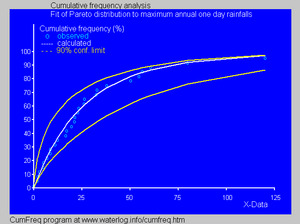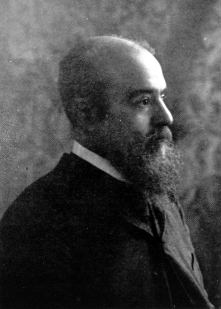Pareto distribution facts for kids
The Pareto distribution is a special way to understand how things are spread out. It's named after an Italian economist named Vilfredo Pareto. This distribution helps us see that in many situations, a small number of things account for a large percentage of the total. Think of it like this: a few big things happen often, while many small things happen less often.
This idea is also called a "power law." It means that if you have a lot of data, you'll often find that a few very large events or values exist, and many, many small ones. For example, a few people might have a lot of money, while most people have less. This distribution is also known as "heavy-tailed" because it shows that very rare, extreme events can still happen.
Contents
Who Was Vilfredo Pareto?
Vilfredo Pareto was born in 1848 and lived until 1923. He was an important Italian economist and sociologist. He became famous for his observations about how wealth was distributed in society.
Pareto noticed that about 80% of the land in Italy was owned by only 20% of the people. This simple observation led to a much bigger idea. He wrote a book called Cours d'économie politique where he explored this pattern. He showed that the number of people with an income higher than a certain amount followed a specific mathematical rule.
How Does It Work?
The Pareto distribution is often used to describe situations where a few large things contribute to most of the outcome. A common example is the "80/20 rule," also known as the Pareto Principle. This rule suggests that roughly 80% of effects come from 20% of causes.
Here are some examples of the 80/20 rule:
- About 80% of a company's sales might come from 20% of its customers.
- Around 80% of software bugs might come from 20% of the code.
- Roughly 80% of complaints might come from 20% of customers.
This distribution helps us understand why some things are very common and small, while others are rare but very large. It's like how there are many small towns but only a few very large cities.
Where Is It Used?
The Pareto distribution is used in many different areas. It helps experts understand patterns in various fields.
Understanding Wealth and Income
One of the first places Pareto used this idea was to study how income and wealth are shared among people. He found that a small percentage of the population often holds a large percentage of the total wealth. This pattern is still seen in many countries today.
Natural Events
Scientists use the Pareto distribution to study natural events. For example, it can help model the size of earthquakes. Most earthquakes are small, but a few are very large and cause a lot of damage. It can also be used for things like the size of forest fires or the amount of rainfall.
Business and Economics
In business, companies use it to understand customer behavior. For instance, a small number of products might generate most of the profit. Insurance companies also use it to predict large claims, like damage from big storms or accidents. This helps them prepare for unexpected events.
Other Examples
You can find Pareto distribution patterns in many other places:
- The number of words in a language (a few words are used very often, many words are rare).
- The size of human settlements (a few very large cities, many small villages).
- The number of links to websites (a few websites have many links, most have few).
The Pareto distribution is a powerful tool for understanding uneven distributions in the world around us. It helps us see that not everything is evenly spread out.
See also




